The Intriguing Combination of Art, History, and Scandal at the Borghese Gallery
- Marianne Hartner-Godown

- Jun 18, 2024
- 9 min read
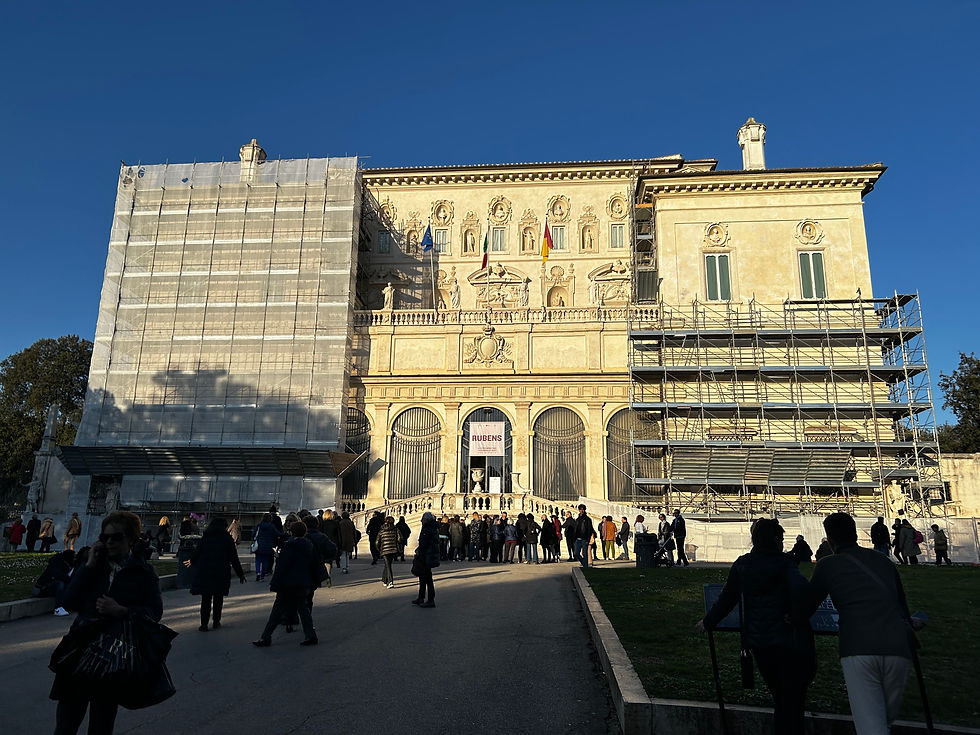
Exterior of the Borghese Gallery
The Borghese Gallery is one of Rome’s most beautiful art museums and one of the most significant art collections in the world. The gallery houses a jaw-dropping art collection in a luxurious garden villa.
The Borghese family is a noble Italian family from Siena, Italy who moved to Rome in the 16th century. Once in Rome, the Borghese family gained prominence and amassed great wealth. The Villa Borghese was originally built to be the private residence of this uber-wealthy dynasty.
The idea to create an art gallery inside the Borghese Villa came from Scipione Borghese, the Pope’s nephew, a cardinal, and a passionate art collector who wanted a place to display and preserve the fine art collection of the family. He wanted to create a “theater of the universe” to entertain VIPs. However, Scipione was a shameless and greedy man. In his obsessive quest to build an unrivaled collection, he used any tactic, however illegal, to acquire a masterpiece he coveted. In 1608, Scipione hired thieves to steal a Raphael masterpiece, The Deposition, from a convent altar. Scipione would confiscate art from people who hadn’t paid taxes. He’d jail artists on fabricated charges who refused to sell their paintings to him. This crooked cardinal would forcibly remove pieces from artists’ studios. Scipione even blackmailed the great Baroque artist Caravaggio, which is how he acquired Caravaggio’s famous piece, David With the Head of Goliath.
In the late 1770s, the Borghese family renovated the villa. They reorganized the collection to improve the viewing experience. Thereafter, the villa functioned as a semi-public museum, only open to select members of the public. In 1902 the museum was sold to the Italian government, and in 1903 it opened as the Galleria Borghese.
The Borghese Gallery is rich in ancient Roman, Renaissance, and Baroque pieces. It houses works from the greatest artists of the time, including Titian, Caravaggio, Raphael, Rubens, and Canova. The gallery has four larger-than-life statues by Bernini, all of which were commissioned by Scipione Borghese, and all of which were sculpted when Bernini was just in his early twenties. Here are just a few of the many not-to-be- missed works you can see at the Borghese Gallery:

The Apothoeosis of Romulus - Mariano Rossi, c. 1775-1779
This extremely large fresco decorates the vault of the Entrance Hall of the Villa Borghese. The auspicious subject was chosen to celebrate the birth of Marcantonio, Borghese’s first son. The significance of this representation celebrates the connection between these two figures: Romulus as the founder of Rome, and Furio Camillo whose heroic actions led him to be known as the “Second Romulus” and honored in ancient sources as a new founder of the Fatherland.

The Rape of Proserpina - Gian Lorenzo Bernini, c. 1621-1622
This is the statue art lovers come for! It depicts a scene in the Greek mythological story of the abduction of Proserpina by Pluto, god of the underworld. Most remarkable is the level of skill it took Bernini to transform marble stone into the appearance of skin. Other details include the sweat dripping down Pluto’s back, and you can see light shining through the cloak of Proserpina. Bernini sanded it down so thin it’s almost transparent!
Left: Floor mosaic with personification of bearded man (Oceanus?), Roman, 3rd century AD
Right: Floor mosaic with personification of a female sea divinity, Roman, 3rd century AD
Both of these intricate mosaics were discovered on the floor of a large Roman villa from the 18th century.

Madonna and Child with Saint Anne - Caravaggio c. 1605-1606
This painting depicts Mary, portrayed with the help of Jesus, crushing a snake at her feet – a symbol of sin, assisted by Anne, mother of the Virgin, portrayed as a humble old commoner with a wrinkled face scarred by time.
Originally this piece was commissioned to be placed above the altar in St. Peter’s Basilica; however, it was almost immediately removed. There are many speculations as to why it was removed. These include its excessive realism (which made it not sacred enough to be worshiped by the faithful), the excessively humanized depiction of Anne who was portrayed as a wrinkled, elderly commoner in a secondary position considering the overall structure of the piece, the Virgin’s low-cut neckline, and the physicality of the baby Jesus (considered too grown to be held in such a way by his mother), helping his mother trample the serpent’s head, which was likely to be misinterpreted by uncompromising Catholics.
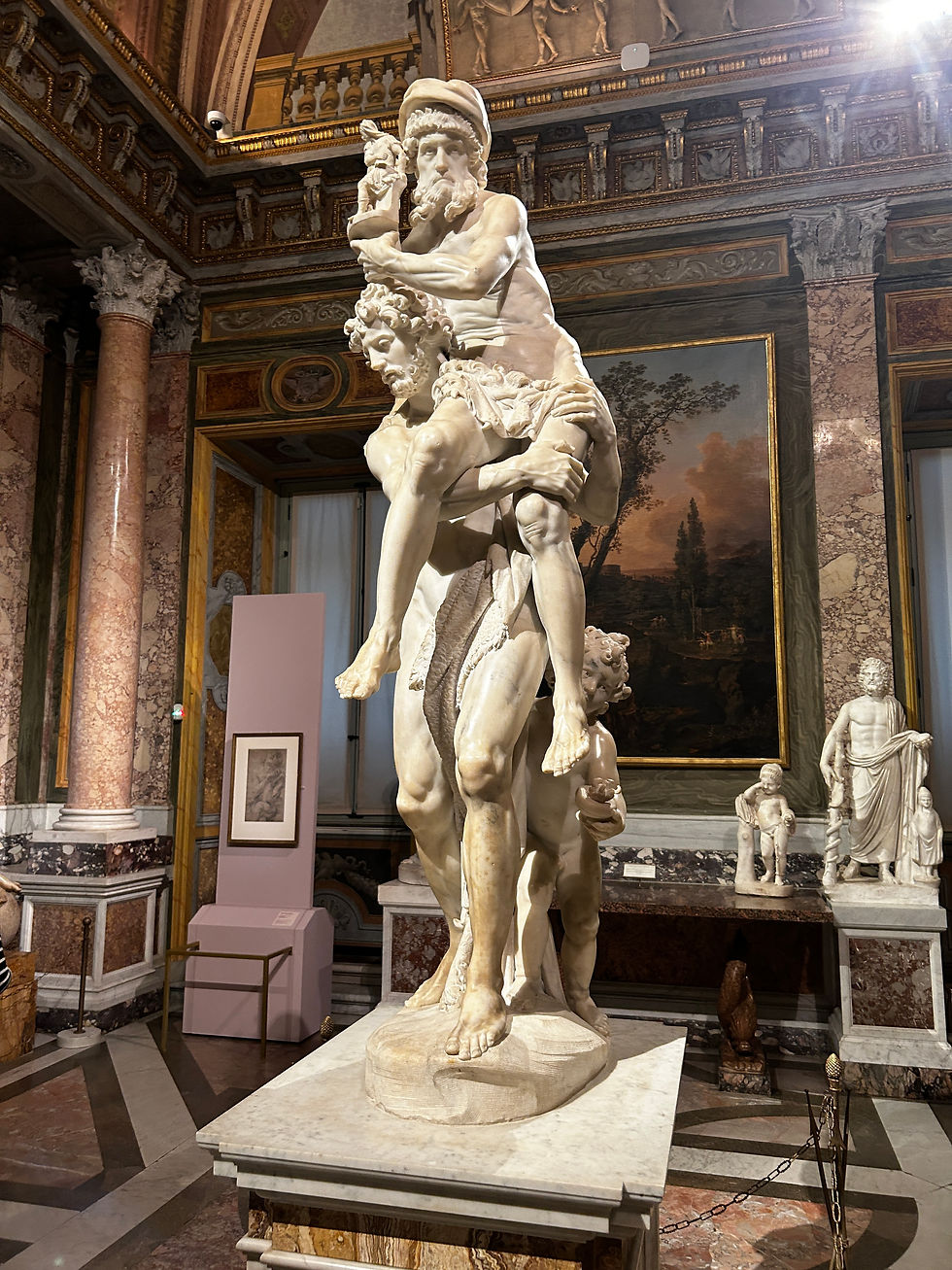
Aeneas, Anchises, and Ascanius - Gian Lorenzo Bernini, c. 1618-1619
Do you remember what you were doing in your early 20s? This sculpture was created when Bernini was only 20 years old! This life-sized group represents three generations of the Aeneas family with the theme of Aeneas’s flight from Troy. The sculpture depicts a scene from the Aeneid, where the hero Aeneas leads his family from the burning city, with his father Anchises on his back, accompanied by his son Ascanius and his wife Creusa. This episode is described by Virgil in the second book of the Aeneid.
In the figures of the father, son, and grandson, there is an apparent reference of the three ages of man. You can this see by the different treatments of the respective surfaces of the bodies of the protagonists: the soft flesh of the child contrasts with the taut skin of the adult, which in turn differs from the withered external appearance of the old man.
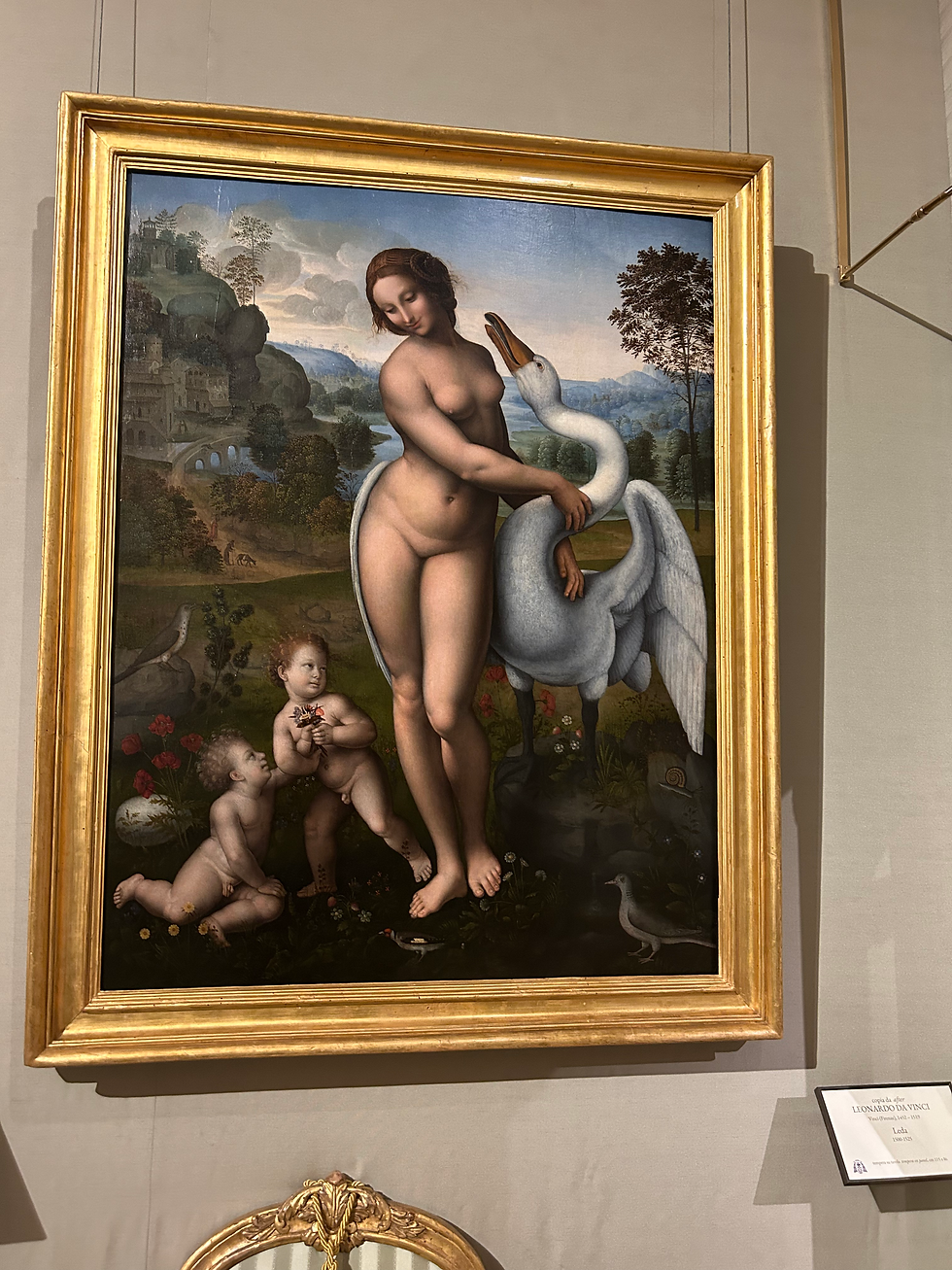
Leda and the Swan - attributed to Il Sodoma or Giovanni Antonio Bazzi, c. 1510-1520
This painting is one of a few reproductions of the original and long lost painting done by Leonardo da Vinci.
The work revisits the ancient Greek myth of Jupiter who transformed himself into a swan out of love for Leda. According to the myth, from the union of Leda and Jupiter disguised as a swan, two brothers of Dioscura were born, Castor and Pollux, shown here on the left as children, while the egg behind them points to the future birth of Helen and Clytemnestra.
The story behind Leda and the Swan was controversial for many, and this could be why a number of paintings of it have been lost, assumed destroyed. There are nine known versions of Leda by Leonardo, including this panel in the Borghese Gallery.

The Last Supper - Jacopo Bassano, c. 1542
Inspired by Leonardo’s painting with its elegant grouping of figures, this scene features barefoot fishermen at the moment when Christ asks who will betray him. Unlike the linear, smooth lining and organization of the twelve apostles present in the Da Vinci masterpiece, the work of art by Bassano expresses a more unorganized scene.

Front of columnar sarcophagus depicting The Labors of Hercules, 160 AD
This is the front of a sarcophagus showing the depiction of the twelve tasks carried out by Hercules.
Having tried to kill Heracles ever since he was born, Hera induced a madness in him that made him kill his wife and children. Afterwards, Heracles went to the Oracle of Delphi to atone, where he prayed to the god Apollo for guidance. Heracles was told to serve Eurystheus, king of Mycenae, for ten years. Eurystheus assigned him ten seemingly impossible tasks to earn atonement. The list was later expanded to twelve when the king declared two of the tasks had been done incorrectly.
This work is one of the first examples of the Asiatic production of arched sarcophagi.

Venus Vitrux - Antonio Canova, c. 1804-1808
This sculpture was commissioned by the second husband of Napoleon Bonaparte’s sister, Pauline. Canova was first instructed to depict Pauline fully clothed as the goddess Diana, hunter and virgin, but Pauline laughed and said that nobody would have believed she was a virgin. She had a reputation for easy promiscuity in France and in Italy. The Emperor’s sister enjoyed courting controversy and posing naked would certainly have raised a few eyebrows in polite society! In this depiction, the apple Pauline holds in her left hand, her fingers wrapped around it suggestive of erotic touch, identifies her as Venus Victorious, the goddess awarded the Golden Apple of Discord, in perhaps the first beauty competition in the history of Western culture.
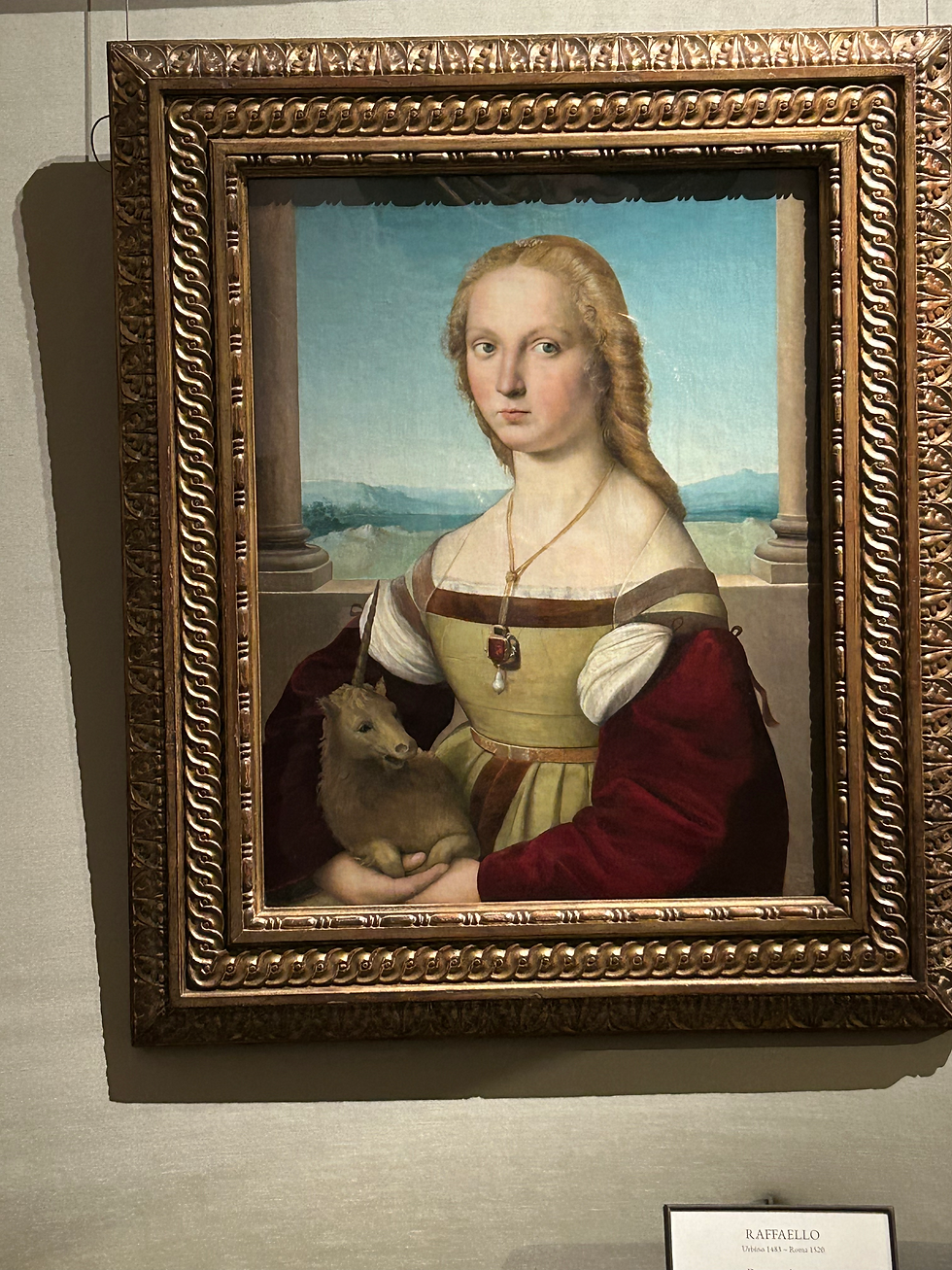
Lady With Unicorn - Raphael Sanzio, c. 1510-1515
At the time Raphael painted this work he was beginning to explore a greater complexity and vibrancy in his art, strongly influenced by the work of his contemporary, Leonardo da Vinci. Many art historians even believe that this painting was inspired by the Mona Lisa, which Leonardo painted at roughly the same time. Both paintings feature a similar composition, with matching poses and similar sizes and background styles.
One of the interesting things to note about this work is that it is very unusual that there are no rings on the woman’s fingers, including wedding rings. This is uncommon because female portraits of that time were usually created on a wedding occasion. At the same time, she holds a tiny unicorn in her hands, which symbolizes purity. Following medieval legends, only a virgin could tame the unicorn.
A restoration was done on this painting in 1959, and it became the primary canvas within the history of the study of X-ray radiography. It was within the course of this restoration that the overpainting was removed, revealing that the unicorn was originally concealing the attributes of the saint’s martyrdom – the wheel and the palm – while a cloak covered her shoulders. These symbols were likely covered up by an unknown painter during the mid-17th century.
Nobody really knows who the mysterious lady could be and even today, her identity remains unknown.

Apollo and Daphne - Gian Lorenzo Bernini, c. 1622-1625
A 24-year-old Bernini created this masterpiece for Cardinal Scipione. It depicts Apollo, the god of light, after being struck by an arrow from Cupid, the god of love, chasing the nymph Daphne who had dedicated her life to Diana the goddess of hunting. Daphne cries out to her father, the god of the woods, for help and he turns her into a laurel tree. Bernini captures the moment her legs turn into roots, her hands turning to leaves and her body turning to bark.
Underneath the statue is an inscription that reads, “Those who love to pursue fleeting forms of pleasure, in the end find only leaves and bitter berries in their hands.”

The Laughing Youth or Head of a Laughing Youth - Anniabale Carracci, c. 1585
This amusing work portrays the face of a smiling young man, depicted with an unusual headdress, which fits well into the context of earlier portraits made by Annibale Carracci. Carracci's interest in caricature is well known, but here he seeks to capture the boy's expression as it is in real life. This is a portrait of an actor, as can be seen from the hat, which was used for the Bolognese mask of the `doctor'. Its spontaneity is enhanced by the strong square cut of the bust and the charcoal lines and brush-strokes, which reflect the speed of which he worked. Because the work is incomplete (made on paper later applied to canvas), it provides a glimpse of the drawing’s outlines, which have been filled in with fluid brushstrokes of dense paint.
The use of expression in this sketch appears to be the beginning of the study of emotions and character types that characterizes 18th-century artistic innovation.
The work is one of Carracci's “small portraits” painted after 1582, where his search for reality was based on simple lines and not the precise reproductions of faces.
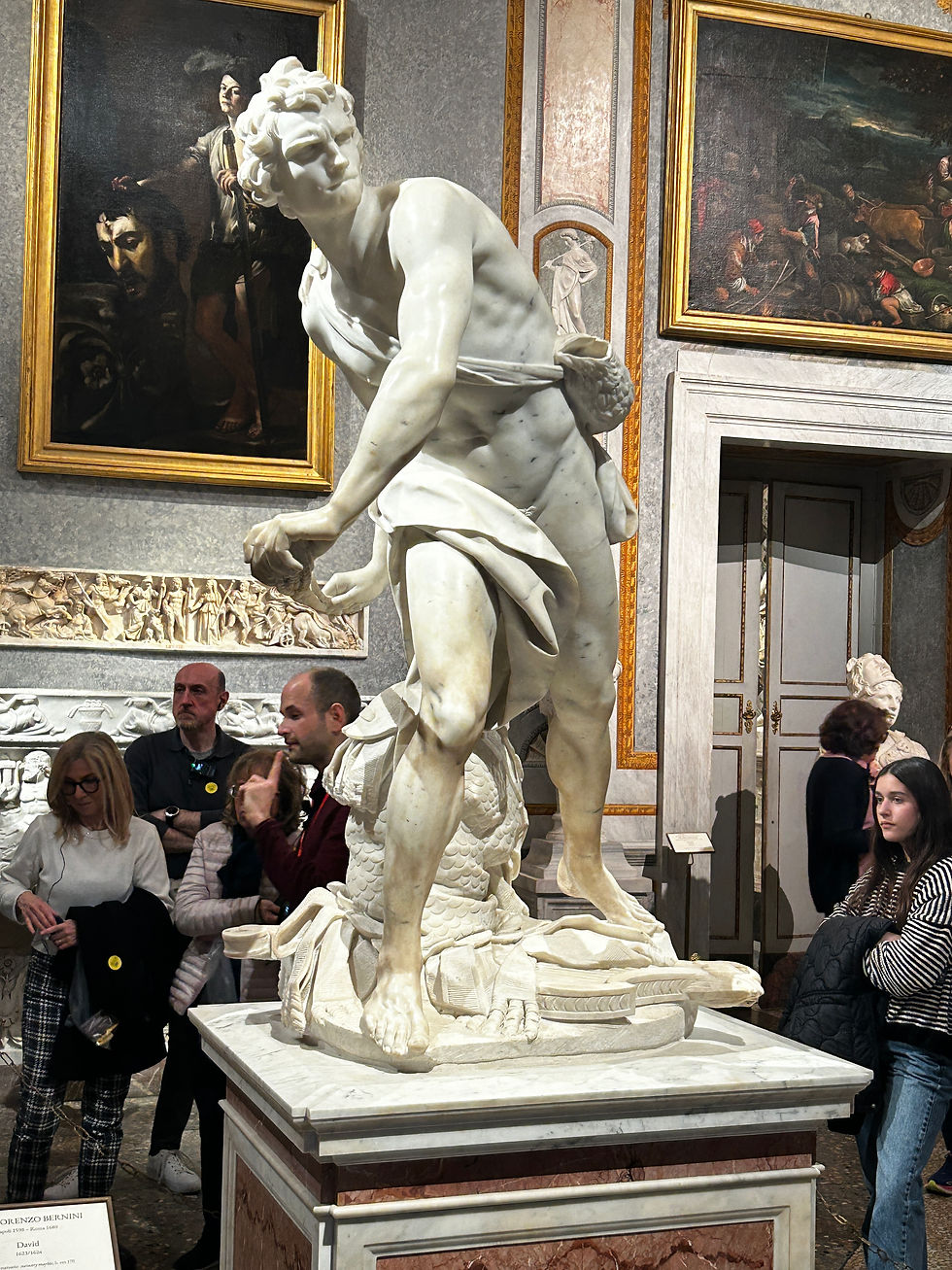
David - Gian Lorenzo Bernini c. 1624
Bernini’s David is interesting because its head is presumably the sculptor’s self-portrait. The young artist sculpted the biblical hero preparing his sling with a rock, just before he is about to strike the gigantic Philistine warrior Goliath. David is almost naked, having refused the armor that King Saul had offered him (the armor is depicted here as well).

Orpheus mosaic - Marcello Provenzale, c. 1618
This mosaic commissioned by Cardinal Scipione Borghese depicts Orpheus, the young shepherd who travels to the netherworld to bring back the soul of the nymph Eurydice, killed by a snakebite. According to the myth, her soul, brought back to this land for a moment, was sent back to the afterlife forever after the hero, disobeying a ban imposed on him by Hades, turned to the threshold of Hell to look at his wife, losing her permanently. Having failed in his attempt, the youth mourns the loss of his beloved and sings a sad song that attracts all the animals. Here he is portrayed seated under an oak, about to touch the bow to the chords of his lira, while behind him, to his left, we can make out the gates of hell enveloped in flames. On Orpheus’s right we can make out the dragon and eagle from the Borghese coat of arms, who, drawn by the sound of a lira, approach the young man, mingling with the other animals.

Truth (Unveiled by Time) - Gian Lorenzo Bernini, c. 1646-1652
At the time Bernini sculpted this piece, he was already one of the most renowned sculptors in Europe. However, his ego suffered a significant blow when he was held responsible for the cracks that appeared in the bell towers he constructed at St. Peter’s Basilica. The towers were way too high and heavy, causing cracks in the facade and had to be taken down. Bernini was said to have begun his sculpture of Truth unveiled by Time to vindicate himself: in time, the truth about the towers would be revealed and his innocence would be proven. It depicts the figure of Truth which is being unveiled by an allegory of time.
Unfortunately for Bernini, he never got around to finishing the figure of Time, even though he already owned the second block of marble that was reserved for this purpose. He was only officially exonerated at the very end of his life, even though his reputation had already been restored a long time before.
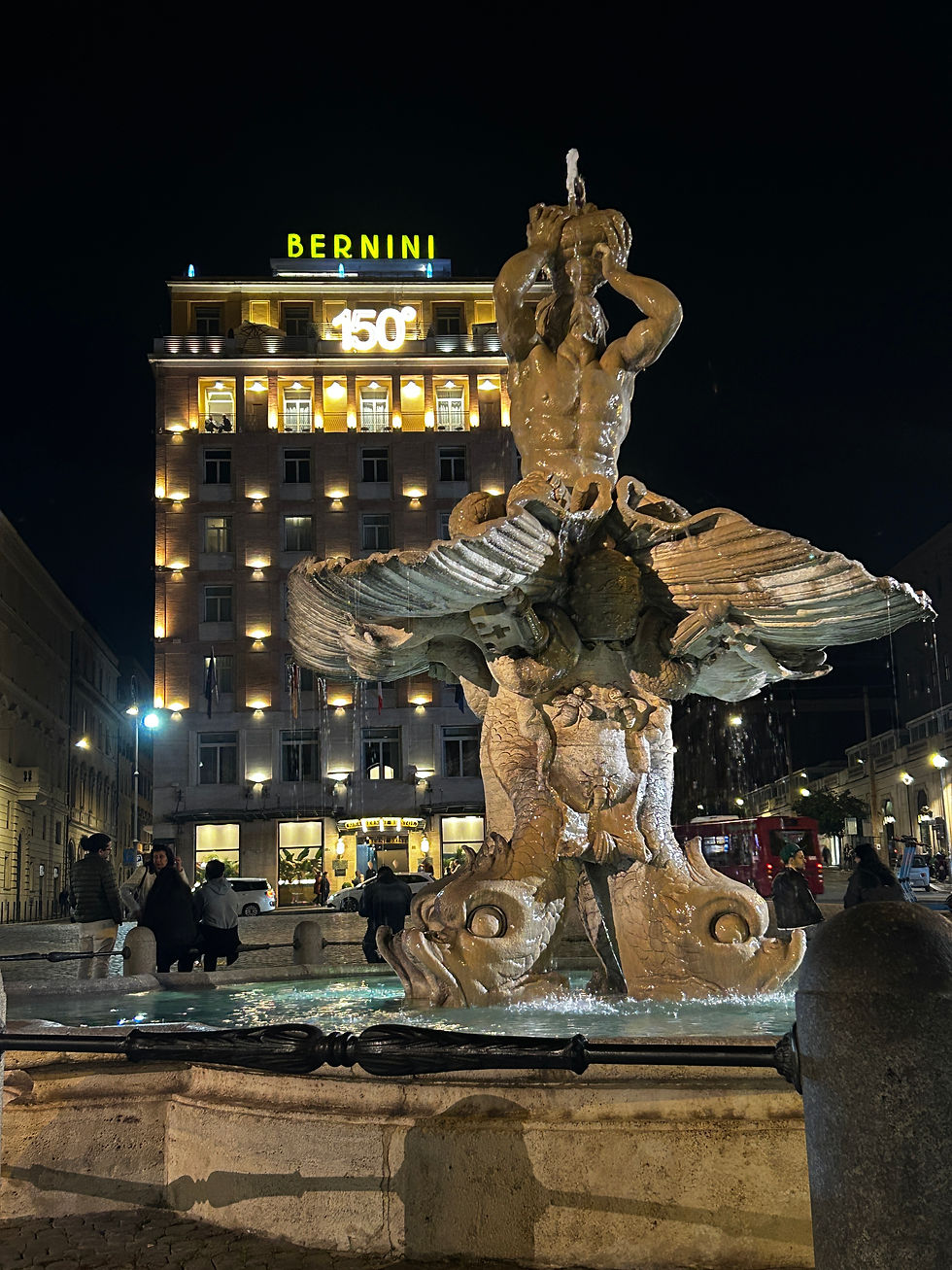
And lastly, here is a view of the Triton Fountain by Bernini at night outside our hotel (see our previous post on the crypts and catacombs of Rome for a description)
For art lovers, The Borghese Gallery is a highlight of any visit to Rome. However, you won’t be able to just walk in and visit the gallery at any time. The gallery has strictly-controlled access with limited tickets, and they only allow visitors two hours to visit the gallery, which means it’s absolutely essential to book a skip-the-line ticket weeks in advance. To get the most out of your visit to the Borghese Gallery, book a guided tour here.








Comments